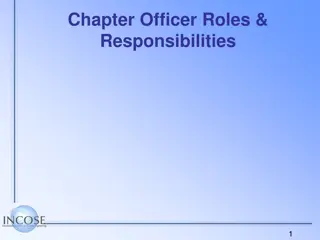
Understanding Econometrics: Key Concepts and Examples
Dive into the fundamentals of econometrics with this comprehensive guide. Learn how to define and conduct an econometric study, explore real-world examples like the impact of good teachers on student outcomes and the applicability of the Law of Demand to electricity, and understand the challenges of forecasting stock returns. Gain insights into the importance of setting a clear purpose for modeling in econometrics and discover the nuances of various economic phenomena.
Download Presentation

Please find below an Image/Link to download the presentation.
The content on the website is provided AS IS for your information and personal use only. It may not be sold, licensed, or shared on other websites without obtaining consent from the author. If you encounter any issues during the download, it is possible that the publisher has removed the file from their server.
You are allowed to download the files provided on this website for personal or commercial use, subject to the condition that they are used lawfully. All files are the property of their respective owners.
The content on the website is provided AS IS for your information and personal use only. It may not be sold, licensed, or shared on other websites without obtaining consent from the author.
E N D
Presentation Transcript
Chapter 1 Introduction
Learning Objectives Define and describe the basics of econometrics Describe how to do an econometric study
Step 1: What Do We Want to Do? Step 1: What Do We Want to Do? The first step in doing econometrics is to define the purpose of the modeling. It is easy to skip this step, but doing so means your analysis is unlikely to be useful. Your purpose should be concrete and concise. Often, if you can state your purpose in the form of a question, you will see whether you have defined it adequately.
Example: Do Good Teachers Produce Example: Do Good Teachers Produce Better Student Outcomes? Better Student Outcomes? https://www.aeaweb.org/articles?id=10.1257/aer.104.9.2593
YES! Good Teachers Raise Future Income YES! Good Teachers Raise Future Income Replacing an average teacher with a teacher in top 5% would increase students earnings later in life by 2.8%. The average 12 year old in the United States can expect lifetime earnings of $522,000. 2.8% earnings bump is worth about $14,500 per student. Multiply that by 20 kids per classroom and an excellent teacher is really valuable.
Example: Does the Law of Demand Example: Does the Law of Demand Hold for Electricity? Hold for Electricity? https://www.aeaweb.org/articles?id=10.1257/aer.104.4.1417
YES! Law of Demand Holds for Electricity YES! Law of Demand Holds for Electricity but only if people know how much they re using only if people know how much they re using but
Example: Is it Possible to Forecast Example: Is it Possible to Forecast Stock Returns? Stock Returns? https://academic.oup.com/rfs/article/21/4/1455/1565737
No! Stock Market Prediction Models are No! Stock Market Prediction Models are Unreliable? Unreliable? Negative means that prediction model is worse than historical mean. IS means in-sample . OOS means out-of-sample .
Step 2: Formulate Your Research Design and Step 2: Formulate Your Research Design and Specify the Econometric Model Specify the Econometric Model Take your abstract objective from step 1 and convert it into an econometric model with data that can answer your questions. Requires some economic theory, common sense and a little cleverness. Making a good choice about which data to collect and use determines whether you will be able to meet your objective.
Step 2 Example: Do Good Teachers Step 2 Example: Do Good Teachers Produce Better Student Outcomes? Produce Better Student Outcomes? Who is a good teacher? Can t just measure test scores. Some teachers may get high test scores because they are easy graders or because smart students take their class. Answer: a good teacher raises test scores more than average With this value added measure of teacher quality, Chetty, Friedman and Rockoff can estimate using econometrics whether students who took classes from high VA teachers earn more later in life.
Step 2 Example: Does the Law of Step 2 Example: Does the Law of Demand Hold for Electricity? Demand Hold for Electricity? Everyone wants to use their AC on hot days Electricity is more expensive on hot days because demand is high on those days To test law of demand, you could give some people a high price and others a low price on the same day Jessoe and Rapson convinced an electric utility to let them raise prices for a random subset of customers Then they estimated using econometrics how consumers responded to the high prices
Step 2 Example: Is it Possible to Step 2 Example: Is it Possible to Forecast Stock Returns? Forecast Stock Returns? Everyone is a stock market expert after the fact (or a bitcoin market expert) Example: historically, the stock market did better in January. Does this mean that the stock market will do better in future Januarys? Hint: no. Welch and Goyal build econometric models of stock returns using historical data and then see whether those models predict future returns.
Step 3: Apply Statistical Theory Step 3: Apply Statistical Theory The Power of Statistics: Statistics lets us make statements of probability about an unobserved population using data from a single sample. Econometrics is challenging because it integrates all three fields economics, mathematics, and statistics into one.
How Does Poverty Affect Student Performance in California Schools? To answer this question, we first need to measure student performance and poverty. Academic performance index (API) The California state government uses it to measure school performance Constructed from students scores on state-wide standardized tests Ranges from 200 to 1000. We can use the API as our measure of average student performance at each California school We do not know the household incomes for each student at each school But U.S. National School Lunch Program provides free lunches to school children from low-income households We know the share of students eligible for free lunches at each school We can use free lunch eligibility (FLE) as an indicator of the share of students from households with incomes below the poverty line at each school.
Table 1.1 Academic Performance Index (API) and Free Lunch Table 1.1 Academic Performance Index (API) and Free Lunch Eligibility (FLE) at 20 Randomly Chosen California Elementary Eligibility (FLE) at 20 Randomly Chosen California Elementary Schools in 2013 (from Total Population of 5,765 Schools) Schools in 2013 (from Total Population of 5,765 Schools) API 960 849 722 914 754 796 802 903 844 963 824 730 826 882 882 736 788 830 981 730 835.80 54.90 81.14 31.00 FLE School Joe A. Gonsalves Elementary Old River Elementary Sierra Vista Elementary West Portal Elementary Isabelle Jackson Elementary Rio Vista Elementary Poplar Avenue Elementary Cloverly Elementary Creative Arts Charter Carolyn A. Clark Elementary Raymond Elementary Fernangeles Elementary Rainbow Ridge Elementary Cyrus J. Morris Elementary Benjamin Franklin Elementary Salvador Elementary Bowers Elementary Vintage Parkway Elementary Balboa Magnet Elementary Selby Lane Elementary County Los Angeles Kern Kern San Francisco Sacramento Orange Butte Los Angeles San Francisco Santa Clara Orange Los Angeles Riverside Los Angeles Riverside Napa Santa Clara Contra Costa Los Angeles San Mateo Mean Std. Deviation 16 0 96 44 83 90 80 46 33 6 69 100 90 29 36 65 59 54 22 80 Source: California Department of Education; http://www.cde.ca.gov/ta/ac/ap/apidatafiles.asp
Figure 1.1 Figure 1.1 2013 API in 20 California elementary schools. Academic performance varies widely across these 20 schools. Mean API for this sample = 835.80. Repeat for many random samples, and on average you would get , the mean API of all schools. But almost certainly does not equal 835.80! (BYAM: It s 813.70. But we don t know that yet!)
Let Free School Lunch Eligibility Proxy for Poverty in School Districts Figure 1.5. It sure looks like API decreases with FLE. What we can learn from FLE to help predict API? Begin by estimating a linear model in which FLE is the only variable explaining API; that is: Error, how much we miss by if we use FLE to predict API for school i = + + Y b b X e Mean=836 0 1 i i i API of school i FLE of school i
What We Learned Econometrics is about making sense of economic data. Three steps to conducting econometric analysis. 1. State the purpose of the analysis. 2. Formulate the research design and specify the econometric model. 3. Apply statistical theory.





